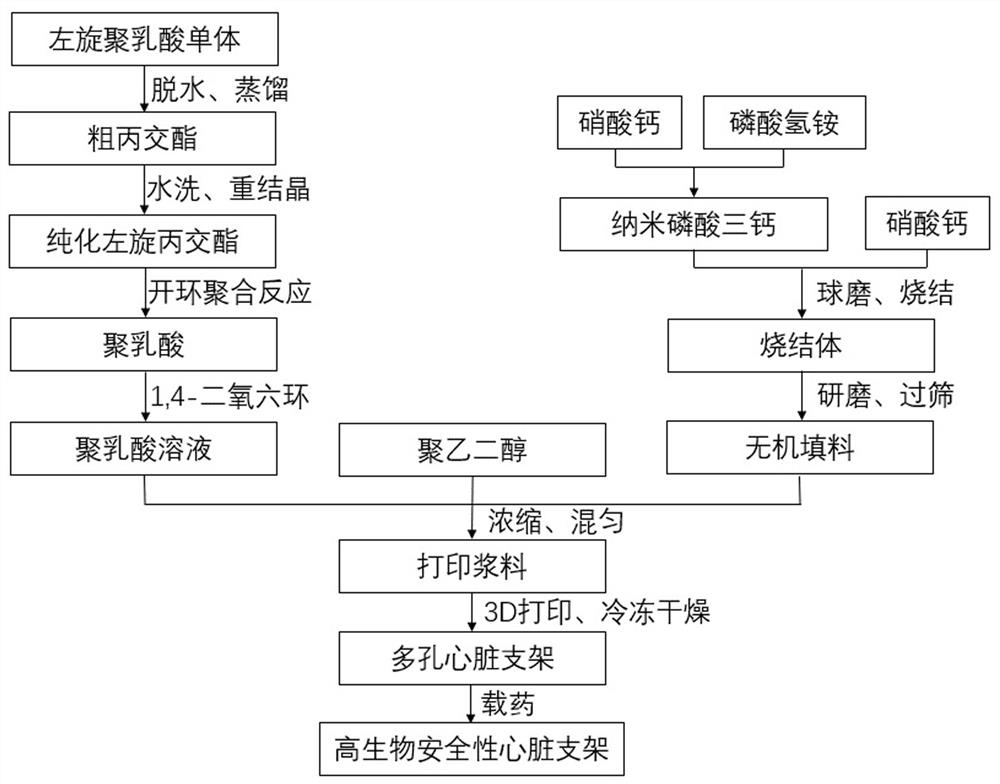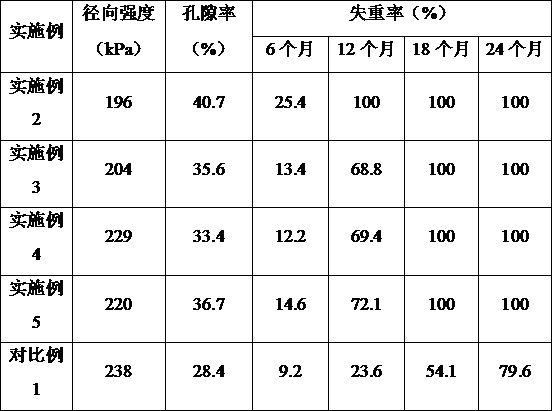A high biosafety heart stent and its manufacturing method
A biosafety, cardiac stent technology, used in drug delivery, pharmaceutical formulations, surgery, etc., can solve the problems of affecting stent blood compatibility, insufficient biosafety, and increase the risk of thrombosis, and achieve high support and biosafety. The effect of improving blood compatibility, improving strength and hydrophilicity
- Summary
- Abstract
- Description
- Claims
- Application Information
AI Technical Summary
Problems solved by technology
Method used
Image
Examples
Embodiment 1
[0054] This embodiment provides a method for manufacturing a high biosafety heart stent, comprising the steps of:
[0055] S1. Polylactic acid was prepared by ring-opening polymerization of lactide, and the polylactic acid was dissolved in 1,4-dioxane according to the mass volume ratio of 1g:10mL, and it was fully stirred for later use;
[0056] The preparation of polylactic acid by the lactide ring-opening polymerization method comprises the following steps:
[0057] S11. Put the L-lactic acid monomer in a round-bottomed flask, heat and dehydrate under reduced pressure at 170°C and 5kPa for 5h, then add 1wt% of stannous octoate as a catalyst, and carry out the third step at 200°C and 0.5kPa. Distillation of lactide, after condensation, crude lactide is obtained;
[0058] S12. Washing and recrystallizing the crude lactide obtained in step S11 in sequence to obtain purified L-lactide; the washing process is to place the crude lactide in deionized water, and perform suction fil...
Embodiment 2~5 and comparative example 1
[0069] Embodiments 2-5 and Comparative Example 1 respectively provide a method for manufacturing a high-biosafety cardiac stent, compared with Example 1, the difference is that Embodiments 2-5 change the time of step S13 ring-opening polymerization reaction , so as to obtain polylactic acid with different molecular weights; Comparative Example 1 did not prepare polylactic acid through step S1, but directly purchased commercially available polymer L-lactic acid with a molecular weight of 900,000. The ring-opening polymerization reaction time corresponding to each embodiment and the molecular weight of polylactic acid in each embodiment and comparative example are shown in Table 2.
[0070] Table 2 The reaction time of ring-opening polymerization and the molecular weight of polylactic acid in Examples 2-5 and Comparative Example 1
[0071] Example Ring-opening polymerization reaction time (h) Molecular weight of polylactic acid Example 2 12 400000 Exam...
Embodiment 6~9 and comparative example 2
[0079]Embodiments 6-9 and Comparative Example 2 respectively provide a method for manufacturing a high-biosafety heart stent, compared with Example 1, the difference is that Embodiments 6-9 have changed the step S3 of nano tricalcium phosphate and The mass ratio of magnesia or the sintering temperature and sintering time of the sintering process; in comparative example 2, nanometer tricalcium phosphate was directly used as the inorganic filler without adding magnesia and sintering process. The mass ratio of raw materials and sintering parameters corresponding to each embodiment and comparative example are shown in Table 4.
[0080] Table 4 The raw material mass ratio and sintering parameters of step S3 in Examples 6-9 and Comparative Example 2
[0081]
[0082] The radial strength, porosity and degradation performance of the high biosafety cardiac stents prepared in Examples 6-9 and Comparative Example 2 were tested, and the results are shown in Table 5.
[0083] Table 5 T...
PUM
| Property | Measurement | Unit |
|---|---|---|
| strength | aaaaa | aaaaa |
| strength | aaaaa | aaaaa |
| thickness | aaaaa | aaaaa |
Abstract
Description
Claims
Application Information
 Login to View More
Login to View More - R&D
- Intellectual Property
- Life Sciences
- Materials
- Tech Scout
- Unparalleled Data Quality
- Higher Quality Content
- 60% Fewer Hallucinations
Browse by: Latest US Patents, China's latest patents, Technical Efficacy Thesaurus, Application Domain, Technology Topic, Popular Technical Reports.
© 2025 PatSnap. All rights reserved.Legal|Privacy policy|Modern Slavery Act Transparency Statement|Sitemap|About US| Contact US: help@patsnap.com



